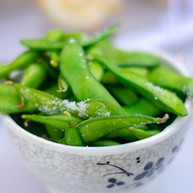Food Stats: Peas
- Linked Fit
- Dec 22, 2020
- 3 min read
Updated: Jul 9, 2021
Overview:
Peas are part of the Pisum Sativum family and have two other variants, the Macrocarpon group, which includes snow peas and snap peas.
Peas originated in the Mediterranean and around central Asia.
Archaeologists have found peas in a variety of different cultures, from tombs to treatises discussing peas.
It is believed that peas were consumed by Europeans dried peas until the 1600s, where they then began to consume fresh peas as a delicacy.
Peas are actually known as a botanical fruit but are generally consumed as a "vegetable".
Peas are harvested during the spring and fall months.
Peas are fairly easy to grow and cultivate from any home garden.
Peas can be consumed solo and or within their pods like snow and snap peas.
Both snow and snap peas can be collectively referred to as "mangetout", which is a French term that refers to both types.

The Look:
Peas are small light green round balls encased around a darker bright green pod. The pod is either edible or inedible depending on the type.
Snow peas have a more flatter pod appearance, where snap peas have a more full-bodied pod appearance.
The pods are about 2 to 3 inches in length which hold about 3 to 10 individual peas.
When selecting snap peas, looks for pods that are full/plum and unblemished. Snow peas should also be unblemished but have a flat pad. Both pods should be dark bright green.
Avoid wrinkled or yellowish tinted peas.
Nutrition:
Vitamin A
Vitamin B such as, B6, thiamine (B1), niacin (B3), folate (B9), and riboflavin (B2)
Vitamin C
Vitamin K
Fiber
Protein
Magnesium
Potassium
Iron
Phosphorus
Copper
Zinc
Antioxidants
Benefits:
Due to the vast amount of nutrients in peas, peas have been known for their benefits on cardiovascular health.
Peas also have properties to improve overall cholesterol levels.
Between both the antioxidant properties and phytochemicals in peas, peas can be beneficial for managing inflammation and having anti-cancer effects.
The various vitamins and minerals in peas aid in blood clotting, enzyme function, DNA regulation, neurological benefits, immune health, this is just the beginning!
Serving Size
1 cup cooked peas or 160 gram
About 120 total calories
About 8 grams of protein
About 23 grams of carbohydrates
About 8 grams of fiber
about 0.5 grams fat
Use & Cooking:
Depending on the type peas can be consumed raw or cooked.
Preferred cooking methods are steaming or sauteing. These two methods tend to have quicker cook times and less liquid, which will help hold more of the nutrients peas have to offer.
If you are using frozen peas in soups or stews add them towards the end of the cooking time.
To shell peas from a fresh pod, snap the top portion of the top and remove the string down the steam by simply pulling it down. Split the pod open and use your hands to remove the peas.
Peas have also been manufactured into protein powders.
Storage:
Peas can be purchased fresh, frozen, or canned.
Store fresh pea in the refrigerator for up to 4 days.
Frozen peas will last a while in the freezer.
If using canned peas, look for options with a lower sodium count.
Recipes:
Stir fry, check out this Meal Prep Stir Fry
Split pea soup
Fried rice
Shepherd's pie
Pea pesto
Rice dishes like risotto
Stews
Roasts
Dahl, W. J., Foster, L. M., & Tyler, R. T. (2012). Review of the health benefits of peas (Pisum sativum L.). The British journal of nutrition, 108 Suppl 1, S3–S10. https://doi.org/10.1017/S0007114512000852
Mudryj, A. N., Yu, N., & Aukema, H. M. (2014). Nutritional and health benefits of pulses. Applied physiology, nutrition, and metabolism = Physiologie appliquee, nutrition et metabolisme, 39(11), 1197–1204. https://doi.org/10.1139/apnm-2013-0557
Rungruangmaitree, R., & Jiraungkoorskul, W. (2017). Pea, Pisum sativum, and Its Anticancer Activity. Pharmacognosy reviews, 11(21), 39–42. https://doi.org/10.4103/phrev.phrev_57_16
Reinhardt, T. (2014). Super Foods (Seconds ed.). Buffalo, NY: Firefly Books Inc.
Sizer, F., Whitney, E. (2011). Nutrition Concepts & Controversies (twelfth ed.). Belmont, CA: Wadsworth











コメント